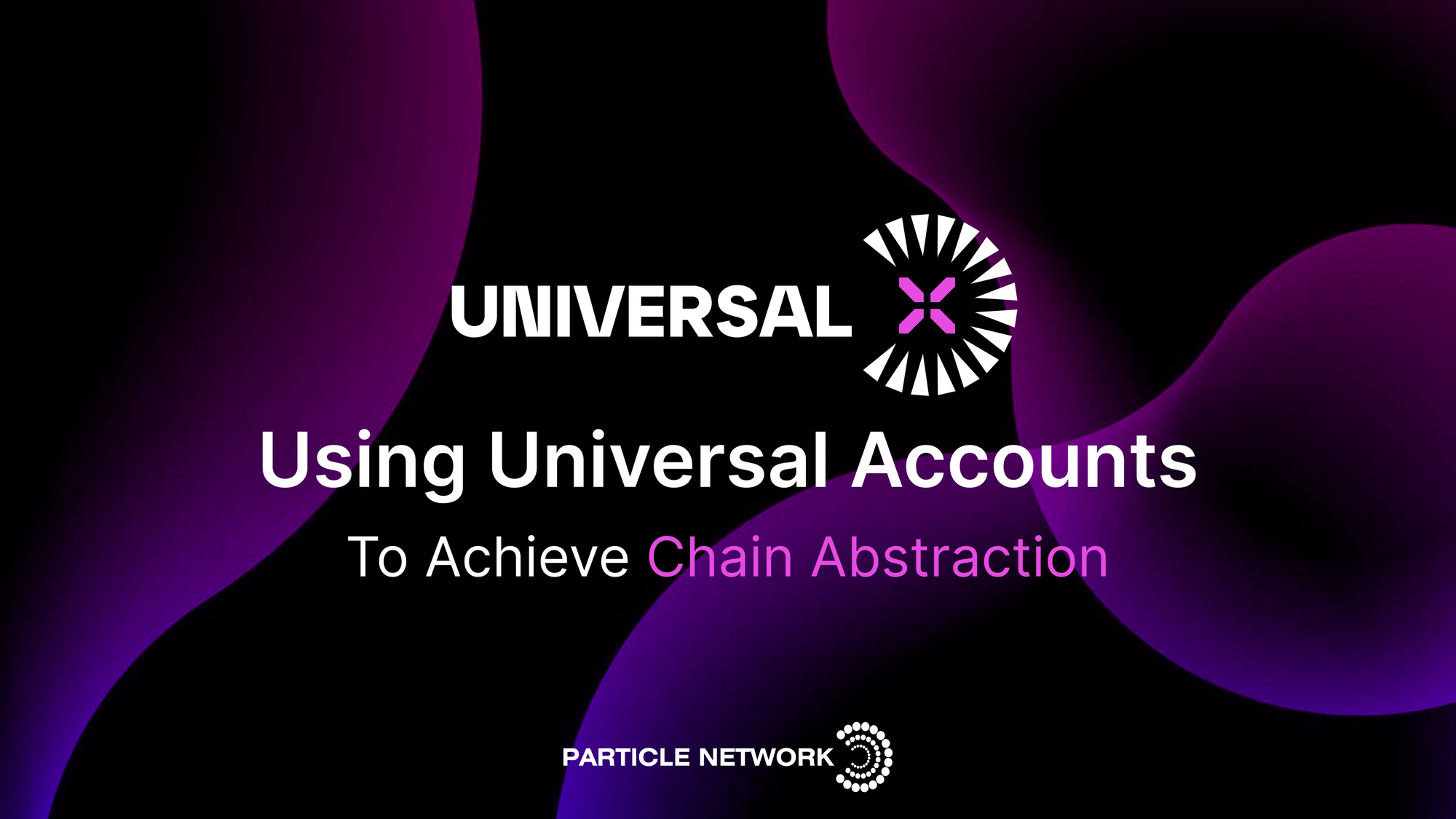An Unparalleled User Experience: How UniversalX Achieves Chain Abstraction

Table of Contents:
Not everything has been said when it comes to chain abstraction. And better yet, a lot remains to be done.
With UniversalX's launch as the first chain-abstracted application (ChApp), chain abstraction has moved from a theory to a proven reality. UniversalX has shown a real demand for apps that allow users to forget about the complexities of interacting with multiple blockchains.
Furthermore, with this release, we’re here to showcase that through the power of ChApps, Web3 can thrive as a whole.
Today, we’re diving head-first into how chain abstraction is achieved within UniversalX, powered by Universal Accounts (UAs). We’ll also take a brief look into how this infrastructure can be leveraged by other ChApps that will be possible once UA infrastructure is widely available, and how we envision this to happen.
Picturing the difference between the transactions made possible by a chain-abstracted vs. a cross-chain dApp.
New to Universal Accounts? Start here
Since UniversalX’s chain abstraction is achieved through Universal Accounts, we’ll introduce a quick recap of their basics here.
Universal Accounts are “one account, one balance, any chain.” This means no bridging, not handling different wallets for every chain, not holding multiple gas tokens, and no need to worry about fragmentation.
In other words, chain abstraction.
There are four key components behind Universal Accounts:
- The Universal Account itself—that is, a single point of interaction controlling an underlying group of Smart Accounts. These, deployed on multiple networks, work in sync to facilitate the experience of one account, one balance, any chain.
- Universal Liquidity, a mechanism composed of multiple liquidity pools, which are used to move users’ assets across chains as needed. This allows users to just interact with dApps, not their tokens’ base blockchains.
- Universal Gas, which applies the principles of Universal Liquidity to let users pay for gas in any token they hold.
- The Particle Chain, the underlying blockchain ordering and ensuring the execution of all cross-chain transactions triggered via Universal Accounts. In other words, UAs’ coordination engine.
How UniversalX leverages Universal Accounts
Let’s now look at how UniversalX takes Universal Accounts and applies them toward fulfilling users’ goals (trading any token, on any chain, without bridging). We can break this implementation into three parts:
- Universal Accounts’ own capabilities:When integrating Universal Accounts, and as a Particle Network product, UniversalX taps into these accounts’ underlying Universal Liquidity. As such, since Universal Liquidity currently relies on five liquidity pools (ETH, USDC, USDT, BTC, SOL), UniversalX incorporates the concept of Primary Tokens.
Primary Tokens are the tokens used to buy assets or be received when selling them on UniversalX. They can be held on any chain, and spent on any chain, collectively.
By using Primary Tokens, UniversalX:
- When buying tokens, reflects Universal Liquidity’s capabilities, translating users’ intents into actionable trades in native DEXs. These trades are then executed with the users’ unified balance of Primary Tokens across all chains.
- When selling, limits the pairs available for users’ trades, allowing itself to tap into rich liquidity pools within these external DEXs.
- Intent-centric architecture and DEX integrations:
It could be said that UniversalX serves as the main interface to utilize a Universal Account to trade onchain.
Two factors play a crucial role in this:
- The translation of users’ intents (e.g., “I want to buy ABC with my XYZ Primary Tokens spread across three chains.”) into an instruction that can be executed by a Filler. The Filler then pays for the trade in the user’s name and receives repayment from their Universal Account.
- The connection with external DEXs, as mentioned, to execute trades. For this, UniversalX relies on aggregators like Jupiter (Solana-based) and Li.Fi (for EVM trades), and OKX OS.
The above can be visualized as follows:
What about the Particle Chain?
As mentioned, the Particle Chain orders and ensures the execution of Universal Accounts’ cross-chain transactions, coordinating all the activities necessary foe users to enjoy a multi-chain balance (such as the above payments and repayments). Currently, the chain uses an internal settlement token to coordinate this. This serves as an interim solution while the network builds operational maturity and the network is further decentralized through the release of $PARTI.
When users initiate actions through their Universal Accounts—whether trading on UniversalX or interacting with future chain-abstracted applications—the Particle Chain:
- Orders incoming transaction requests
- Coordinates with Liquidity Providers across different chains
- Ensures successful execution of cross-chain operations
- Validates transaction completion
This bootstrapping phase allows the network to establish operational patterns and execution guarantees while building a verifiable track record of cross-chain transaction handling.
Infrastructure for everyone in Web3’s new era
As we release the Universal Accounts infrastructure for Web3 builders of all kinds to have plug-and-play access to chain abstraction, we’re convinced that the power of Universal Accounts in both their capabilities and neutrality. Both UAs and the Particle Chain exist as to serve every use case and market imaginable.
With the upcoming release of the Universal SDKs, and leveraging EIP-7702, dApps and wallets will be able to become chain-abstracted through essentially two lines of code. This means no migration headaches, no architectural overhauls—just instant access to chain abstraction for all dApps or wallets that want to plug into Universal Accounts.
This positioning creates a unique dynamic: while Particle Network operates UniversalX as the first and one of the largest chain-abstracted applications, it will simultaneously power all other ChApps through its infrastructure. With a dual role as operator and enabler, Particle Network positions itself in the center of Web3 developments, creating a virtuous cycle that benefits all participants in Web3.
Mega bullish on UAs as infrastructure
UniversalX showcases how adopting Universal Accounts can represent a shift in Web3 applications’ architecture, strategy, and deployment. This creates local and systemic improvements, such as:
- Erasing the technical barriers between blockchain ecosystems. Applications will no longer need to choose between chains or manage complex bridging mechanisms—they can operate across the entire Web3 retaining a simple user experience.
- Efficient liquidity utilization. By pooling assets across chains through UAs, users’ same capital can serve multiple purposes without being locked in chain-specific silos, incentivizing the Web3 economy.
- Blockchains optimizing for better, more exciting use cases for developers, rather than optimization for end user attraction. As end users gain the ability to interact with any application, chains can focus on attracting developers through unique features.
Universal Accounts are fundamentally reimagining how Web3 applications can operate. As UniversalX demonstrates, the future of Web3 isn't about choosing between chains, but rather developers leveraging their favorite ones—or all of them at once! and users not having to think about them.
Particle Network's Chain Abstraction solutions are 100% free for developers and teams. By integrating them, you can set your project in a path to leveraging chain abstraction.
About Particle Network

Particle Network powers chain abstraction, addressing Web3's fragmentation of users and liquidity. This is enabled by Particle's Universal Accounts, which give users a unified account and balance across all chains.
Share this article
About the author(s)


